MARIANI’SVirtual Gourmet
June 10, 2012
NEWSLETTER
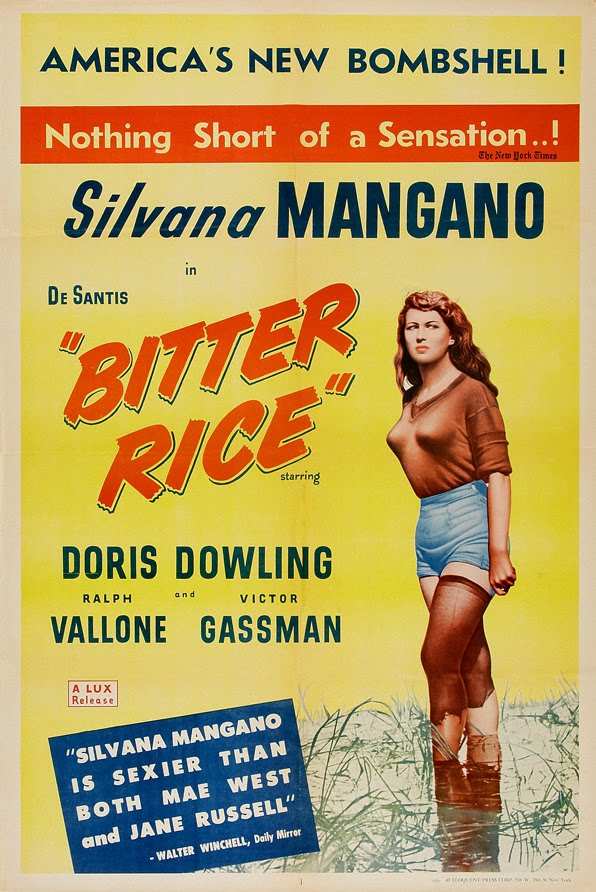
❖❖❖

FLASH ANNOUNCEMENT!
There will be no issue of Mariani's Virtual Gourmet next week, June 17, because Mariani will be in Italy on assignment.
The next issue will appear June 24.
❖❖❖
Punta Mita
by Carey Sweet
NEW YORK CORNER
NoMad
by
John Mariani
❖❖❖
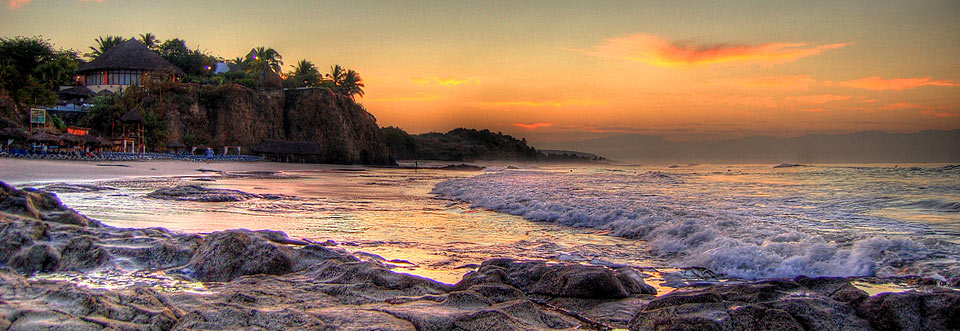
By Carey Sweet
As a 1,500-acre beachfront
village nestled on the north end of Bahía de
Banderas in the Mexican state of Nayarit,
development is limited to several private estate and
villa communities. At the heart St.
Régis and Four
Seasons resorts. Once a visitor gets past the
guard-gated entry, there is little reason to leave,
and so much enticement to unwind. Punta Mita is
located 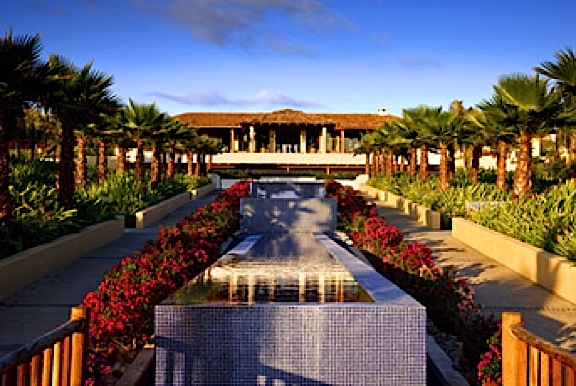 just about 10 miles north of Puerto
Vallarta but is worlds apart from that bustling town
of all-inclusive hotels, nightclubs and tourist
shopping.
just about 10 miles north of Puerto
Vallarta but is worlds apart from that bustling town
of all-inclusive hotels, nightclubs and tourist
shopping.
Indeed, the word "mita" has been
traced back to ancient Aztec language as meaning
"Gateway to Paradise." There is golf at two Jack
Nicklaus courses, played directly along the Pacific
Ocean and off the “Tail of the Whale,” a par-three
hole on the largest natural island green in the
world. I can kayak, sail and snorkel, and sunbathe
on miles of quiet, white sand beaches year-round,
since average summer temperatures are 85°
(crashing to 75° during winter). For the
deep-pocketed - and let’s be honest, most guests
here are - there is private yacht rental, from
either hotel. In the spring, the community hosts a
Gourmet & Golf Classic (2011 was the inaugural
year) for a lavish celebration of food, wine and
tequila. Chefs from around the world converge on the
Four Seasons and St. Régis for four days of
over-the-top parties, lunches and dinners,
showcasing foods as tantalizing as tripe tacos and
as intriguing as Victorian kangaroo pie. The
festivities include friendly golfing competition,
and, when I visited for the 2012 Classic, more Veuve
Clicquot poured than I’ve ever seen in my life.
As soon as I arrived at the St.
Régis for my check-in, a chilled flute of the
champagne was placed in my hand. Another was offered
as my private butler led me to my garden
suite. At the opening reception that evening at the
resort’s ocean front Sea Breeze Beach Club, some 200
guests worked their way through 80 bottles of Veuve
Clicquot, as well as the copious wines, martinis,
margaritas and whiskies also being offered.
While the Gourmet Classic takes
place just once a year, a lavish lifestyle is a
Punta Mita hallmark year-round. It’s evident from
the very lobby of the St. Régis, where
cocktails are offered from an open bar on the back
patio that acts as theater overlooking gardens,
fountain pools and a swath of azure ocean framed by
palm trees. Opened in November, 2008, the property
features 89 guest rooms, 30 suites and a
three-bedroom presidential suite, with buildings
cloistered in two-story casita arrangements that
include bonuses like private patios and outdoor rain
showers. Spread over 22 acres of private peninsula,
recreation includes three restaurants, three
infinity pools with private cabanas, a fitness
center, private beach club, tennis courts, and a
10,000 square foot Remède spa. For the
resort’s grand opening during this ongoing recession
time, just one guest room was booked, I learned. For
the Classic weekend, the property was at 99 percent
occupancy.
 It’s clear this isn’t
rustic Mexico. Actually, if there’s any drawback,
the Punta Mita experience is so manicured it might
be anywhere with a gorgeous beach – Hawaii, Fiji, or
the like. As a cap, we can visit an expansive sales
center that invites us to purchase Punta Mita
property. And I love it all. The décor
breathes comfortable opulence throughout, in lavish
accents of Mexican galarza stone, river stone,
marble, onyx, wood and clay, paired with Old World
European furnishings. In the mornings, complementary
coffees and pastries are delivered to the
rooms, and in the afternoon, an elaborate tea
service is hosted in the lobby.
It’s clear this isn’t
rustic Mexico. Actually, if there’s any drawback,
the Punta Mita experience is so manicured it might
be anywhere with a gorgeous beach – Hawaii, Fiji, or
the like. As a cap, we can visit an expansive sales
center that invites us to purchase Punta Mita
property. And I love it all. The décor
breathes comfortable opulence throughout, in lavish
accents of Mexican galarza stone, river stone,
marble, onyx, wood and clay, paired with Old World
European furnishings. In the mornings, complementary
coffees and pastries are delivered to the
rooms, and in the afternoon, an elaborate tea
service is hosted in the lobby.
“Please let me know how I can
serve,” said my butler as he showed me how to work
the complicated phone system that could be used to
summon him 24 hours a day. A private butler is St.
Régis signature, and while in reality the
butler is no different from a bellman or concierge
at any fine property, it’s certainly fun to say, as
in “more Veuve Clicquot, please, private butler.”
Fair warning: this resort is very
popular with families tugging along herds of small
children. Perhaps the kids like soccer games on the
lawn next to the casual, al fresco Las Marietas
Mexican restaurant, or the piñata parties
that staff set up on the beach, or playing Bingo in
the La Tortuga Children's Club.
Yet there is plenty of adult-only
escape, too, notably the resort’s signature
restaurant Carolina. Ambitious adult tastes are fed
very well here, with dishes like Caribbean lobster
roasted with spices and served atop fennel
mousseline with a hint 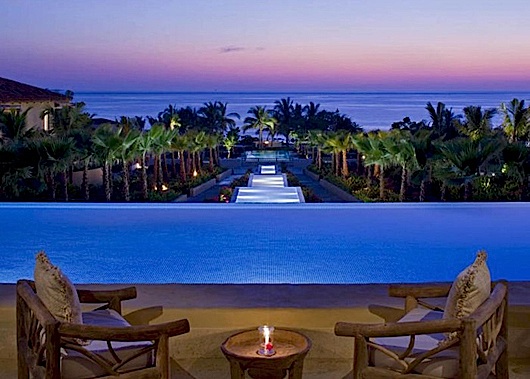 of Papantla
vanilla and coriander vinaigrette. Executive chef
Sylvain Desbois emphasizes seafood, done in rich
flavors and vibrant colors, such as a dramatic
spider crab decorated with lemon confit and fennel
atop melon-mint gazpacho, or the Canelón,
bringing an artichoke stuffed with lobster, foie
gras and earthy truffle.
of Papantla
vanilla and coriander vinaigrette. Executive chef
Sylvain Desbois emphasizes seafood, done in rich
flavors and vibrant colors, such as a dramatic
spider crab decorated with lemon confit and fennel
atop melon-mint gazpacho, or the Canelón,
bringing an artichoke stuffed with lobster, foie
gras and earthy truffle.
This is also where I savored some
Mexican wines, as a welcome alternative to the
mostly South American and Italian brands I so often
see in Mexican restaurants. One of my favorites,
Casa Madero of Valle de Parras in Coahuila, is
renowned as the oldest winery not just in Mexico but
in all the Americas, and makes a very good 2V Chenin
Blanc-Chardonnay blend, plus a delightful 3V blend
of Cabernet Sauvignon, Merlot and Tempranillo that
drinks like silk.
Much of a vacation can be made
napping happily on cushy canopied day beds on the
beach, cooled by caressing breezes and complementary
popsicles offered by staff. So it was that well-fed
and well-golfed through the Gourmet Classic, my
biggest exertion on this most recent trip ended up
being a visit to the spa. At this sanctuary, the
relaxation lounge spans through open, draped walls
to gardens set with a Jacuzzi and plunge pools. Yet
the massage actually rejuvenated my lazy bones, with
the therapist using firm, quick strokes and slow,
deep kneading pressure to unlock stress points I now
could not conceive how I had ever managed to
acquire.
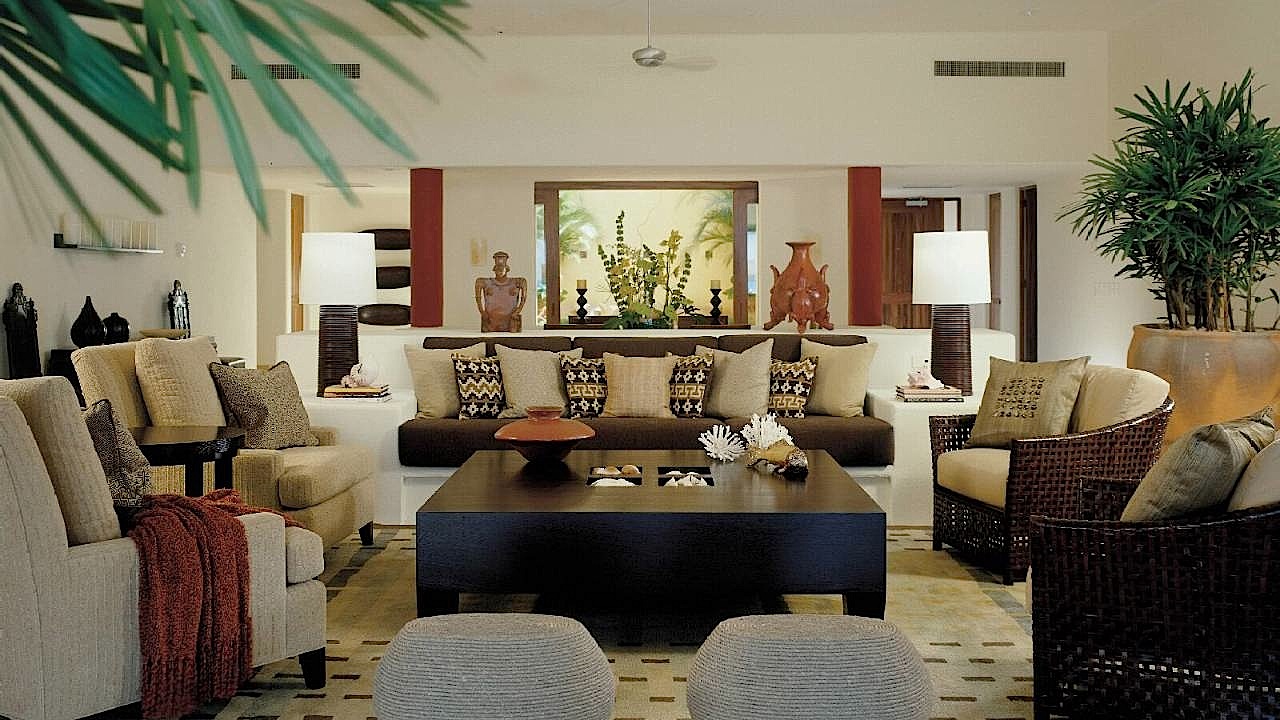 The Four
Seasons is a pleasant, picturesque walk up the beach
from St. Régis, though most visitors between
the two properties will take a chauffeured golf cart
or car. From one dramatic entry to the next, both
resorts compete for the luxury market, though the
Four Seasons seems geared more toward adult
recreation with its high-end boutiques for snapping
up goodies like regionally crafted jewelry and art.
The Four
Seasons is a pleasant, picturesque walk up the beach
from St. Régis, though most visitors between
the two properties will take a chauffeured golf cart
or car. From one dramatic entry to the next, both
resorts compete for the luxury market, though the
Four Seasons seems geared more toward adult
recreation with its high-end boutiques for snapping
up goodies like regionally crafted jewelry and art.
In fact, kids are sequestered
within their own resort-within-a-resort, in the
Oasis complex, a family-oriented building that
houses 23 rooms and suites and is encircled by a
Lazy River meandering pool for inner tube rides on a
gentle current.
One must-do here is the market
catch meal at Bahía, the new Richard Sandoval
beachfront grill and bar. The “coastal Latina”
eatery debuted in February, as a more casual
follow-up to Four Seasons’ Ketsi,
which Sandoval introduced in 2009. Three times a
week, the chefs gather on the Las Cuevas beach to
welcome in a local fishing boat, and work with
Puerto Vallarta area fishermen to select the best
daily catch. After a discussion with their guests
about the colorful choices hauled in – red snapper,
yellowfin tuna, dorado (mahi mahi), octopus,
colorful Parrot Fish, and a flat-bodied beach
flounder looking quizzically with both its eyes on
one side of its head – they display the whole fish
on ice in a canoe, sparkling against the sun and a
backdrop of manzanillo trees. I selected
my fish, and the chefs prepared it to order. Chef
Sandoval himself happened to be on site that day,
conducting one of the optional cooking classes
available with the market lunch, and he worked the
open-air flames alongside his executive chef
Philippe Piel.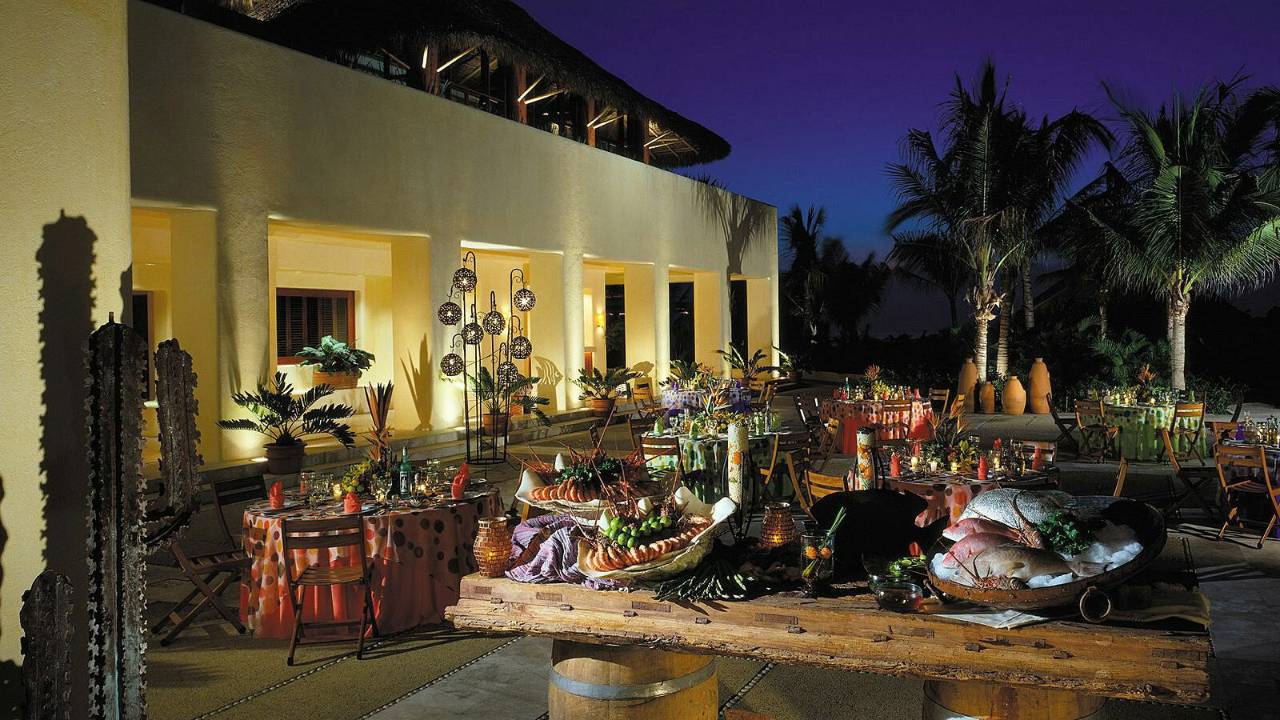
This experience truly spoke of
seaside Mexico, in the appetizer of grilled octopus,
the tender-chewy seafood tossed with nopales pico de gallo,
tomatoes, queso
fresco, mild panela cheese, and black olives in
a vibrant preserved lemon-honey vinaigrette with
plenty of gutsy Serrano chile kick. Fresh pink
snapper was next, quickly marinated in citrus,
tomato and an array of chiles, slathered in
mayonnaise for a lovely moist, tangy crust, and
grilled in a basket before being plated with crunchy
chayote-cabbage-carrot slaw.
Another irresistible indulgence
is booking the Four Seasons’ 55-foot private yacht,
complete with a Wave Runner tacked on the back of
the boat. This is hardly an everyday voyage,
spanning a six-hour tour up and down the Puerto
Vallarta coastline and around the nearby Marietas
Islands for bird watching. If the shaded relaxation
area on the upper deck, or sunning areas on the bow,
stern and rear upper deck prove too tiresome, we can
retreat to the living room and kitchen, or the posh
sleeping suites with private baths. Constantly, the
ship butlers offer us more tequila, more sushi, and
more Veuve Clicquot.
Sayulita
Travelers seeking a more real taste of Mexico can
drive to Sayulita, about a half-hour northeast of
the resorts. You bump along sandy roads until around
a bend, you discover a tiny village flanking a
bohemian beach where visitors and surfers like to
camp, or stay in casual B&B’s and no-frills
bungalows.
 You can eat
well here. Capitan Cook is a popular hangout,
touristy with its palapa-topped beachfront structure
and gringo dishes like a shrimp burger. But ask for
the specialty, which is "sarandeado," meaning a whole fish
grilled on wood fire so the skin crisps and the meat
roasts moist and succulent. You can drink here, with
cold beers and stiff, sweet cocktails the most
popular choice. And you can shop here, with some
worthwhile purchases, since development over the
past few year has brought in a small array of art
galleries and notable boutiques next to the curio
stores selling Nacho Libre wresting masks.
You can eat
well here. Capitan Cook is a popular hangout,
touristy with its palapa-topped beachfront structure
and gringo dishes like a shrimp burger. But ask for
the specialty, which is "sarandeado," meaning a whole fish
grilled on wood fire so the skin crisps and the meat
roasts moist and succulent. You can drink here, with
cold beers and stiff, sweet cocktails the most
popular choice. And you can shop here, with some
worthwhile purchases, since development over the
past few year has brought in a small array of art
galleries and notable boutiques next to the curio
stores selling Nacho Libre wresting masks.
If you’ve planned your trip for
spring, you may wrap up your vacation with Gourmet
& Golf Classic farewell gala dinner (the
upcoming event is scheduled for April 15 to 28,
2013). In 2012, the supper took over the deck of the
infinity pool at the Four Seasons, the sparkling
water appearing to flow seamlessly into the ocean,
dancing with the sunset dipping in salute to the
Sierra Madre mountains in the distance. Top chefs
took the stage for applause after preparing their
global feast, including Michael Mina, Richard
Sandoval, Patricia Quintana, Kaz Okochi, Jose Salas,
Claudia Fossa, Ramon Bramasco and Philippe Piel.
Yet, no matter the time of year,
and for pure do-nothing vacation bliss with or
without fancy chefs, Punta Mita remains truly that "Gateway
to Paradise."
NEW YORK CORNER
NoMad
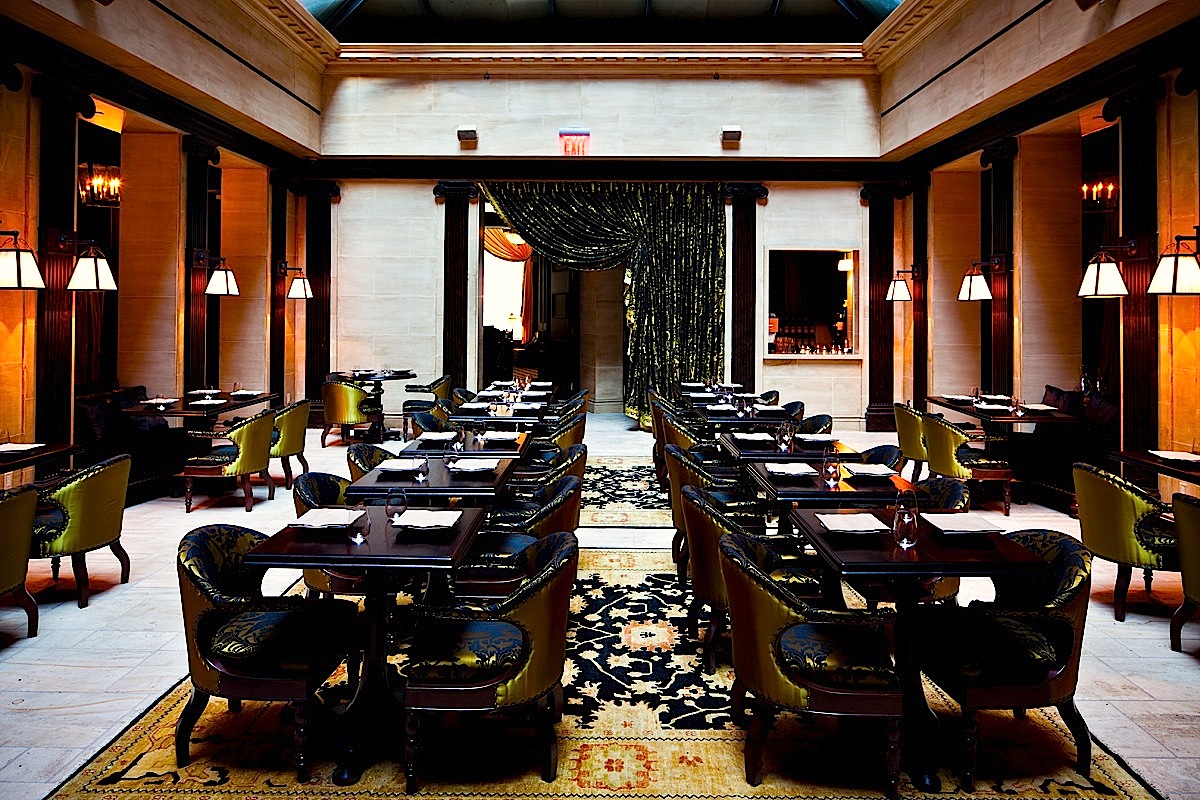
NoMad Hotel
1170 Broadway (near 28th Street)
212-796-1500
http://www.thenomadhotel.com/
While
a tiny handful of modernist cuisiniers are
busy levitating food in balloons and cooking a
sous-vide omelet for 35 minutes, there is
still an admirable number of young chefs’
whose creativity is to find ways simply to
make their food taste better and more intense,
even it’s a few carrots on a plate.
This is the goal of Daniel Humm (below),
who has already established his mastery as
chef-partner at the deluxe Eleven Madison
Park. Now, at NoMad, in the new hotel of the
same name, he is proving that exquisite
food 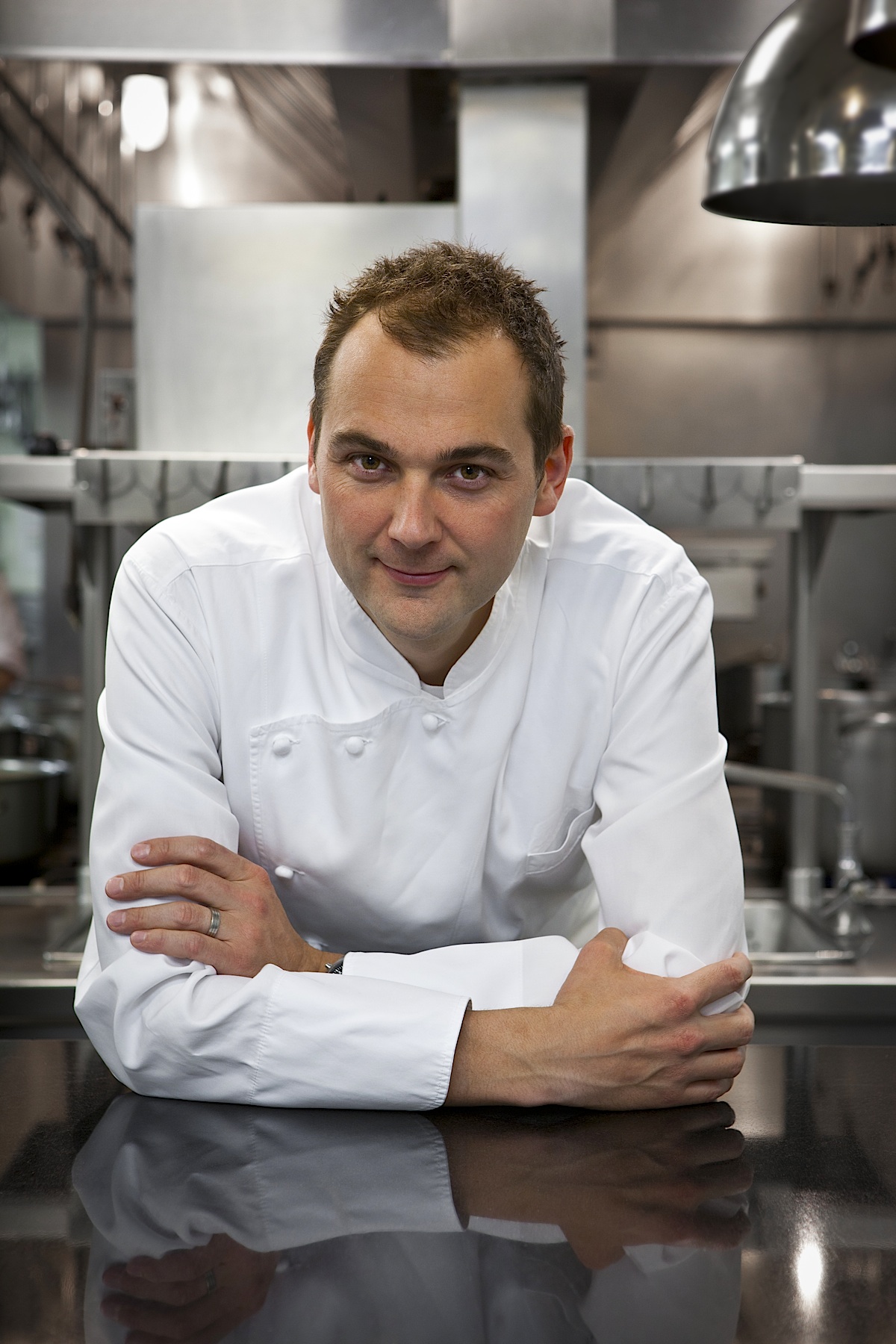 can be
made almost rustic and wholly unpretentious,
tasting like nothing you’ve quite tasted
before. Back to those carrots: Humm uses three
different heirloom types, dusts them with
cumin then roasts them with crispy duck skin
that infuses them with richness; lastly, he
gives them further texture with a scoop of
nutty wheat berries. The dish is a triumph
that is clearly thought through to the point
where enough is enough, and everything on the
plate matters. No levitation, no gels, nothing
sprayed or squeezed out a bottle. Yet it is a
case of a simple vegetable transformed. Humm
has indicated that he’s more and more
fascinated by vegetable cooking, and it shines
through some equally impressive meat, fish,
and poultry dishes on NoMad’s menu.
can be
made almost rustic and wholly unpretentious,
tasting like nothing you’ve quite tasted
before. Back to those carrots: Humm uses three
different heirloom types, dusts them with
cumin then roasts them with crispy duck skin
that infuses them with richness; lastly, he
gives them further texture with a scoop of
nutty wheat berries. The dish is a triumph
that is clearly thought through to the point
where enough is enough, and everything on the
plate matters. No levitation, no gels, nothing
sprayed or squeezed out a bottle. Yet it is a
case of a simple vegetable transformed. Humm
has indicated that he’s more and more
fascinated by vegetable cooking, and it shines
through some equally impressive meat, fish,
and poultry dishes on NoMad’s menu.
The
premises within the hotel are comprised of
several rooms,  the main dining room
(above)
set beneath a skylight that would make this a
fine place for an exhibit of ballet sculptures
by Degas. Indeed, the space has the look of a
sexy fin-de-siècle boutique museum,
right down to the very comfortable tufted
chairs. Tablecloths would be a most welcome
amenity, if only to dampen the sound of the
rock and roll music piped in.
the main dining room
(above)
set beneath a skylight that would make this a
fine place for an exhibit of ballet sculptures
by Degas. Indeed, the space has the look of a
sexy fin-de-siècle boutique museum,
right down to the very comfortable tufted
chairs. Tablecloths would be a most welcome
amenity, if only to dampen the sound of the
rock and roll music piped in.
To the left is another
dining room, without skylight and therefore
considerably darker, and to the rear a very
popular, well-lighted bar. To the right is a
curtained-off private dining room, and very
soon they will open the open rooftop air
terrace as a separate restaurant, whose view
of the NYC skyline is astounding, with the
Empire State smack in front of you and the
gleaming Chrysler Building in the background.
There’s a lot of
fleet-footed staff at NoMad and they are all
very good at what they do, not least sommelier
Thomas Pastuzak, whose
selection of unfamiliar small estates contains
plenty of gems at very good prices, not least
a crisp selection of international Rieslings.
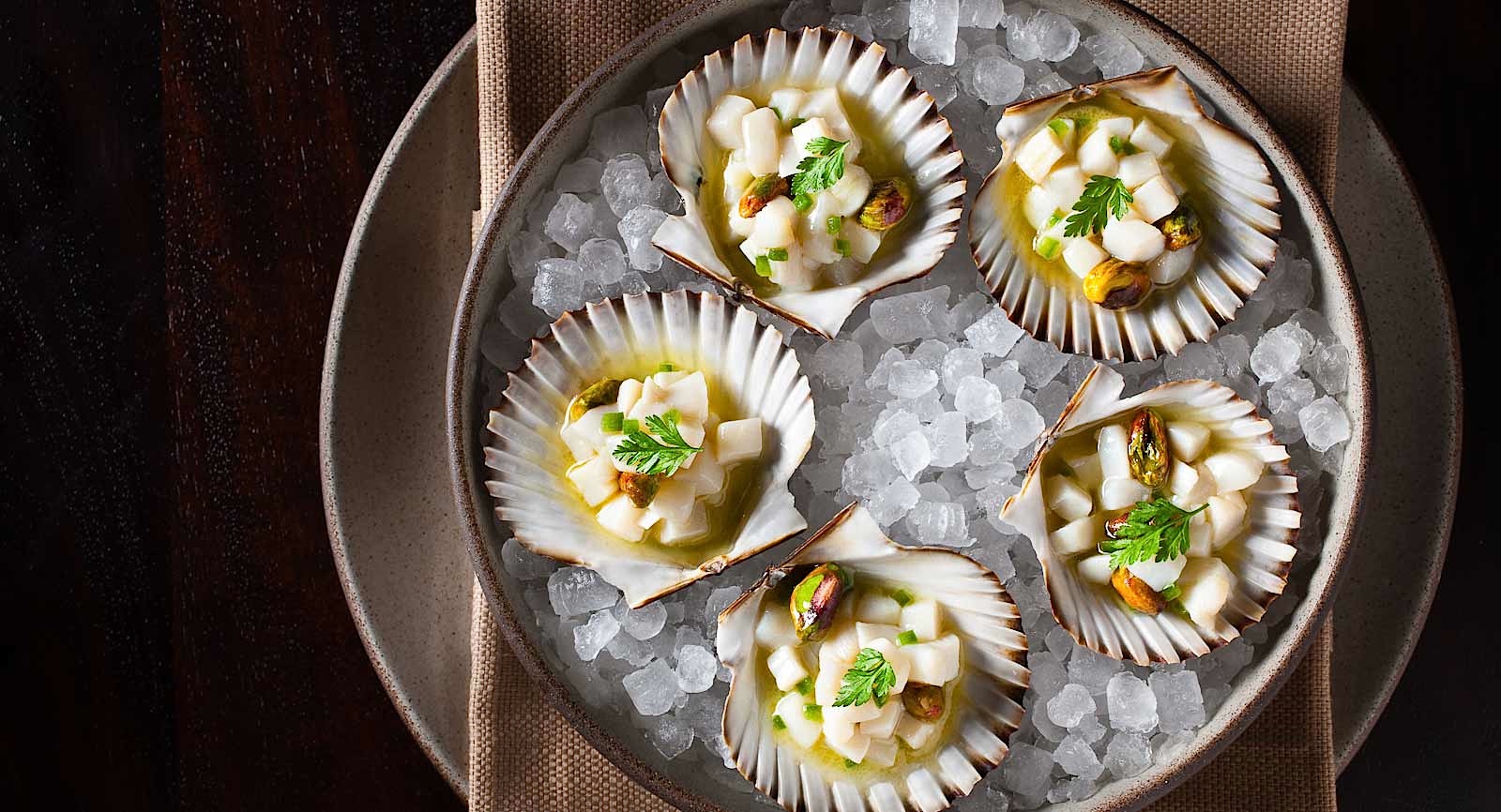 You
begin here with a whole loaf of seriously
additive onion bread, good with anything to
follow, like the generous display of fruits de
mer (left),
including sea urchins and ceviches, all with a
judicious jab of acidity that really sparks
the appetite. In a little cup are served what
look like thin spring rolls, which in a French
kitchen go by the name croustillants,
here stuffed with wonderfully juicy
sweetbreads. There is a a summer-bright dish
of sweet snow peas with pancetta, pecorino and
mint, and I can’t imagine anyone not swooning
over Humm’s light tagliatelle with King crab,
a touch of Meyer lemon and black pepper. Humm
has always done some of the best foie gras in
NYC, and here it comes as a creamy round with
the meat of tête
de cochon, lovely radishes, and
nasturtiums. He cooks lobster just to the
point of tenderness then bathes it in a
minestrone with fava beans, lemon verbena, and
pasta.
You
begin here with a whole loaf of seriously
additive onion bread, good with anything to
follow, like the generous display of fruits de
mer (left),
including sea urchins and ceviches, all with a
judicious jab of acidity that really sparks
the appetite. In a little cup are served what
look like thin spring rolls, which in a French
kitchen go by the name croustillants,
here stuffed with wonderfully juicy
sweetbreads. There is a a summer-bright dish
of sweet snow peas with pancetta, pecorino and
mint, and I can’t imagine anyone not swooning
over Humm’s light tagliatelle with King crab,
a touch of Meyer lemon and black pepper. Humm
has always done some of the best foie gras in
NYC, and here it comes as a creamy round with
the meat of tête
de cochon, lovely radishes, and
nasturtiums. He cooks lobster just to the
point of tenderness then bathes it in a
minestrone with fava beans, lemon verbena, and
pasta.
What does an inventive chef
do that’s new with beef? Buy the finest, for
starters, then crust it with bone marrow and
add ramps and morels to make a dish as rich as
any I’ve ever had and as good as any in recent
memory.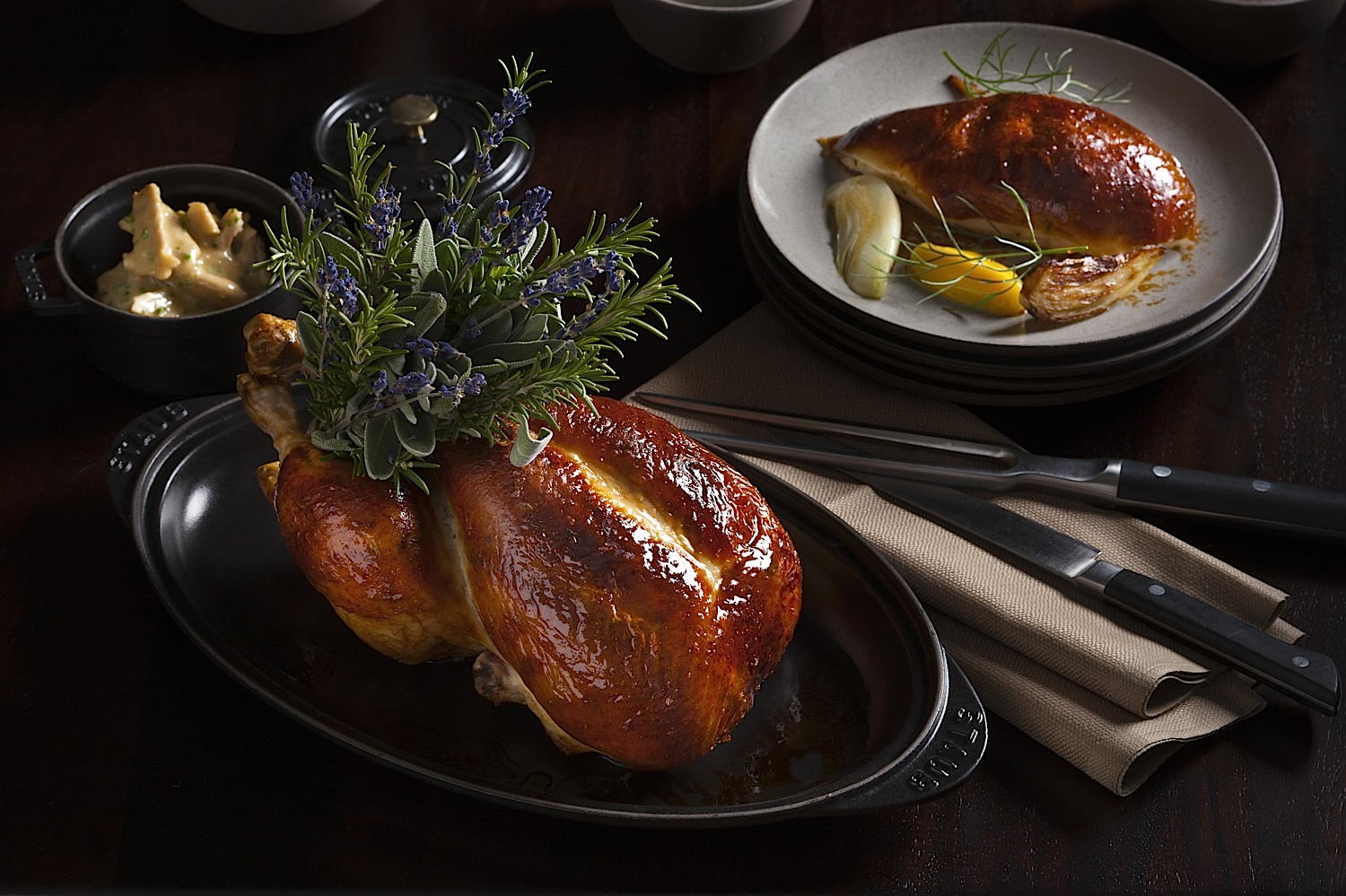
We were urged to try what’s
already become NoMad’s signature dish, a whole
roasted chicken for two (right),
which I imagined would merely be impeccably
cooked, crisp chicken of impeccable
provenance. But Humm won’t let it go at that:
the whole bird, burnished dark brown, is first
presented to the table in a black iron dish,
then taken back to be carved. What you get on
the plate is succulent chicken under whose
skin has been packed foie gras and black
truffles with brioche crumbs--a mimicking of
Veal Orloff done with poultry. I told my wife
I thought the filling almost overpowered the
chicken, to which she arched and eye and
replied, “It’s so good, who cares?”
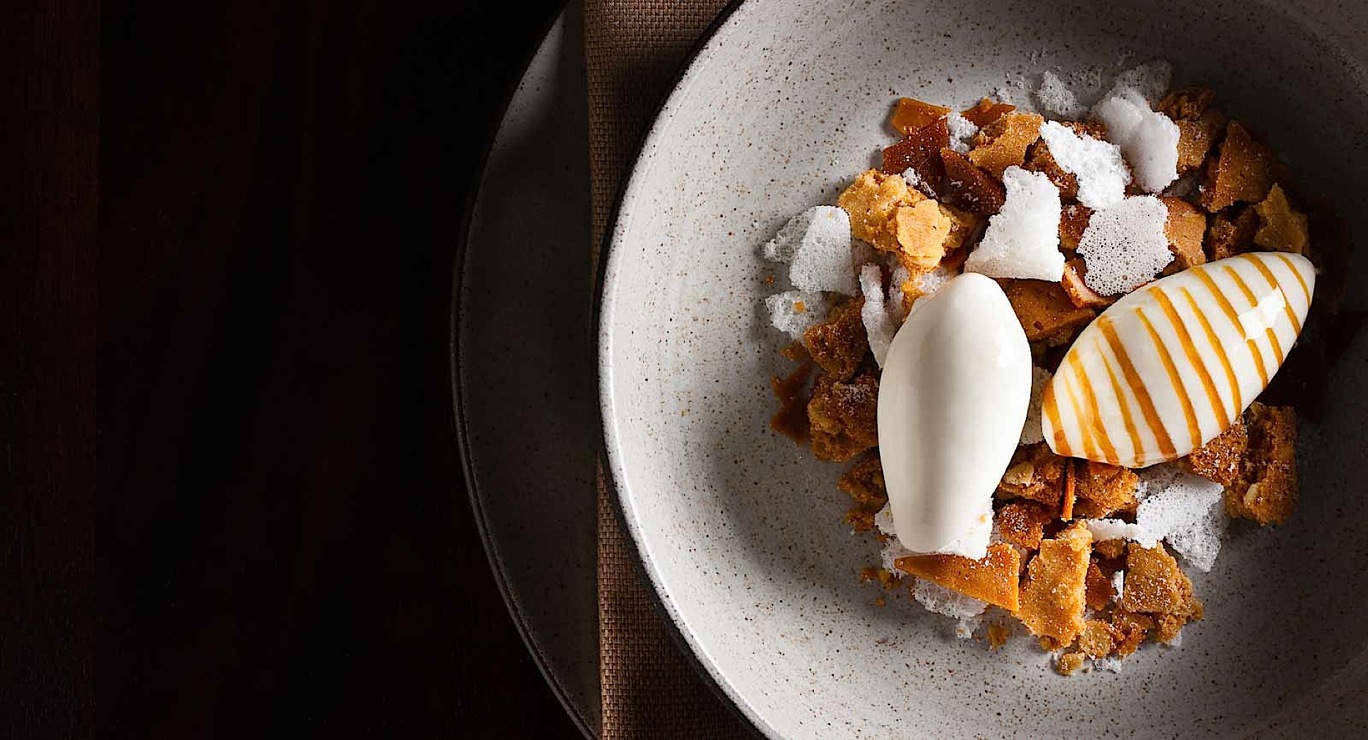 By
this point in a near-perfect meal, I assumed
the desserts would have a lot to live up to,
and they passed with flying colors, most of
all “milk and honey,” which is composed of
quenelle-like milk ice cream with shortbread
and cereal flake-like brittle (left).
Espresso affogato
with vanilla ice cream, granita
and espuma
succeeded on sheer good taste, although a
lemon custard with almond shortbread and
ricotta had a somewhat metallic taste lemon
can sometimes impart.
By
this point in a near-perfect meal, I assumed
the desserts would have a lot to live up to,
and they passed with flying colors, most of
all “milk and honey,” which is composed of
quenelle-like milk ice cream with shortbread
and cereal flake-like brittle (left).
Espresso affogato
with vanilla ice cream, granita
and espuma
succeeded on sheer good taste, although a
lemon custard with almond shortbread and
ricotta had a somewhat metallic taste lemon
can sometimes impart.
NoMad is a restaurant based
on Humm’s thorough mastery of classic
techniques that he has applied to create new
concepts without manipulating his ingredients
into bizarre forms. There are restaurants as
good as NoMad elsewhere in NYC and certainly
in Paris, but there is none really quite like
it anywhere.
NoMad is open for breakfast, lunch, and
dinner daily. Snacks and appetizers at
dinner run $8-$24, entrees $20-$37.
❖❖❖
 JEEZ, THEY COULD
JEEZ, THEY COULD
HAVE AT LEAST GONE TO PIZZA HUT!
Zillionaire Facebook entrepreneur Mark
Zuckerberg and bride Priscilla Chan (left) enjoyed a
romantic honeymoon dinner in Rome at. . . .
McDonald’s!!
NOW, THEN, MR. GOREN, JUST LIE
BACK AND TELL US ABOUT
WHY YOU HATED YOUR MOTHER'S STEAK AND
KIDNEY PIE. 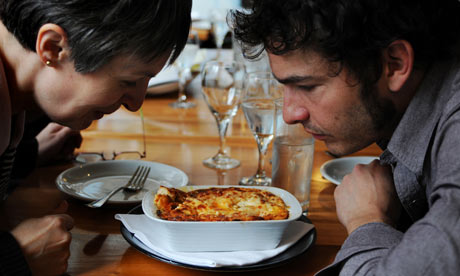
"I’ve changed. I used to be so angry.
I think back to my early days as a critic in the late
1990s, and I blush. I would go swaggering into
restaurants in some ridiculous tramp disguise,
challenging them to mistreat me, order the things I
was least likely to enjoy, then hurl my plate aside in
a fury and demand to see the manager. When I got home,
I would sit down and slaughter the place, from the
‘demented holocaust of care-home pelmetry and Argos
furniture they call a dining room’ to the ‘wall-eyed
gargoyle of a waitress whose breath alone took three
years off my life in the short time it took her
to say the word “soup”' to ‘the chef whose signature pigeon and
chocolate dish I can only assume to have been some
sort of elaborate suicide note’. I
wasn’t happy unless jobs were lost, reputations were
ruined and ‘closed’ notices were up in the window by
the end of the week. I remember reading an interview
in the Financial
Times with the owner of a restaurant I’d just
panned, in which he declared that ‘Giles Coren’s
review cost me £150,000,’ and thinking, ‘Is that
all?’"--Giles Coren (right),
The Guardian
(5/24/12)
Any of John Mariani's
books below may be ordered from amazon.com.
 |
My latest book, which just won the prize for best book from International Gourmand, written with Jim Heimann and Steven Heller, Menu Design in America, 1850-1985 (Taschen Books), has just appeared, with nearly 1,000 beautiful, historic, hilarious, sometimes shocking menus dating back to before the Civil War and going through the Gilded Age, the Jazz Age, the Depression, the nightclub era of the 1930s and 1940s, the Space Age era, and the age when menus were a form of advertising in innovative explosions of color and modern design. The book is a chronicle of changing tastes and mores and says as much about America as about its food and drink.
“Luxuriating vicariously in the pleasures of this book. . . you can’t help but become hungry. . .for the food of course, but also for something more: the bygone days of our country’s splendidly rich and complex past. Epicureans of both good food and artful design will do well to make it their coffee table’s main course.”—Chip Kidd, Wall Street Journal.
“[The menus] reflect the amazing craftsmanship that many restaurants applied to their bills of fare, and suggest that today’s restaurateurs could learn a lot from their predecessors.”—Rebecca Marx, The Village Voice. |
"Eating Italian will never be the same after reading John Mariani's entertaining and savory gastronomical history of the cuisine of Italy and how it won over appetites worldwide. . . . This book is such a tasteful narrative that it will literally make you hungry for Italian food and arouse your appetite for gastronomical history."--Don Oldenburg, USA Today. "Italian
restaurants--some good, some glitzy--far
outnumber their French rivals. Many of
these establishments are zestfully described
in How Italian Food Conquered the World, an
entertaining and fact-filled chronicle by
food-and-wine correspondent John F.
Mariani."--Aram Bakshian Jr., Wall Street
Journal.
"Equal parts
history, sociology, gastronomy, and just
plain fun, How Italian Food Conquered the
World tells the captivating and delicious
story of the (let's face it) everybody's
favorite cuisine with clarity, verve and
more than one surprise."--Colman Andrews,
editorial director of The Daily
Meal.com. "A fantastic and fascinating
read, covering everything from the influence
of Venice's spice trade to the impact of
Italian immigrants in America and the
evolution of alta cucina. This book will
serve as a terrific resource to anyone
interested in the real story of Italian
food."--Mary Ann Esposito, host of PBS-TV's
Ciao
Italia. "John Mariani has written the
definitive history of how Italians won their
way into our hearts, minds, and
stomachs. It's a story of pleasure over
pomp and taste over technique."--Danny Meyer,
owner of NYC restaurants Union Square Cafe,
Gotham Bar & Grill, The Modern, and
Maialino.
|
 |
 |
 |
 |
 |
 |
 |
 |
❖❖❖
 Everett Potter's Travel Report:
Everett Potter's Travel Report: 
 Eating Las Vegas
is the new on-line site for Virtual Gourmet
contributor John A. Curtas., who since 1995
has been commenting on the Las Vegas food
scene and reviewing restaurants for Nevada
Public Radio. He is also the
restaurant critic for KLAS TV, Channel 8 in
Las Vegas, and his past reviews can be
accessed at KNPR.org.
Click on the logo below to go directly to
his site.
Eating Las Vegas
is the new on-line site for Virtual Gourmet
contributor John A. Curtas., who since 1995
has been commenting on the Las Vegas food
scene and reviewing restaurants for Nevada
Public Radio. He is also the
restaurant critic for KLAS TV, Channel 8 in
Las Vegas, and his past reviews can be
accessed at KNPR.org.
Click on the logo below to go directly to
his site.

Tennis Resorts Online: A Critical Guide to the World's Best Tennis Resorts and Tennis Camps, published by ROGER COX, who has spent more than two decades writing about tennis travel, including a 17-year stretch for Tennis magazine. He has also written for Arthur Frommer's Budget Travel, New York Magazine, Travel & Leisure, Esquire, Money, USTA Magazine, Men's Journal, and The Robb Report. He has authored two books-The World's Best Tennis Vacations (Stephen Greene Press/Viking Penguin, 1990) and The Best Places to Stay in the Rockies (Houghton Mifflin, 1992 & 1994), and the Melbourne (Australia) chapter to the Wall Street Journal Business Guide to Cities of the Pacific Rim (Fodor's Travel Guides, 1991).


MARIANI'S VIRTUAL GOURMET
NEWSLETTER is published weekly. Editor/Publisher: John
Mariani.
Contributing Writers: Christopher Mariani, Robert Mariani,
John A. Curtas, Edward Brivio, Mort Hochstein,
Suzanne Wright, and Brian Freedman. Contributing
Photographers: Galina Stepanoff-Dargery,
Bobby Pirillo. Technical Advisor: Gerry McLoughlin.
To un-subscribe from this newsletter,click here.
© copyright John Mariani 2012
